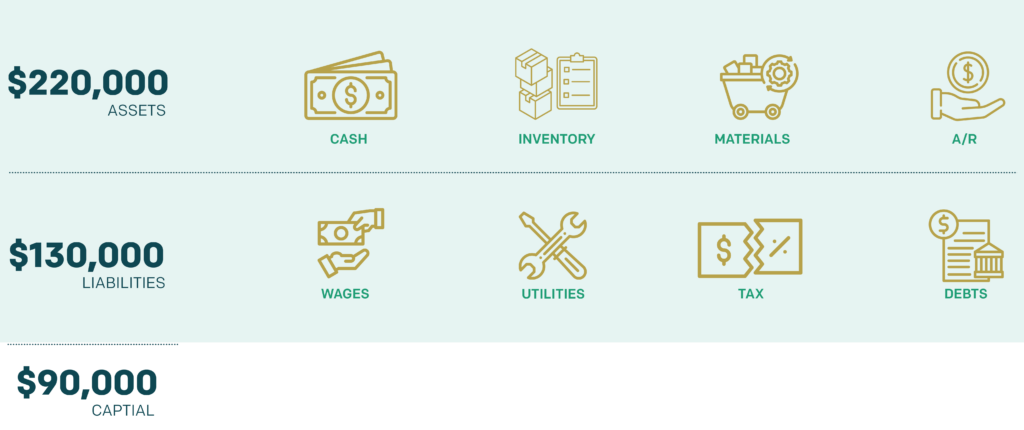Working capital — also known as net working capital (NWC) — is a metric that tracks the amount of funds a business requires to meet its daily expenses. Or, more simply, it identifies the difference between what your business has and what it owes. The size of this gap will significantly influence your overall success and your options regarding future plans and business growth.
Given the importance of this metric in understanding your short-term business health, we’ll explore working capital throughout this article, noting what it is, how to calculate it, and its overall impact on your day-to-day performance.
Increase working capital with automated A/R
Eliminate processing delays and accounting errors with A/R automation
What is working capital defined as, and what is it used for?
In more detail, working capital refers explicitly to the difference on your balance sheet between your current assets — anything that can be converted to cash in the next year — and your current liabilities — anything that needs to be paid out in the next year. This pool of funds, in turn, represents your overall liquidity, meaning the amount of money your business can quickly access to cover its operating costs.
Want to make the most of your working capital? Check out our blog:
By tracking this metric, your company can also more easily gauge the level of flexibility it has to invest in measures beyond the day-to-day, such as expanding into a new market or upgrading critical equipment. Similarly, a small or negative value — particularly when persistent — can warn that your organization is struggling and appropriate measures should be taken.
Of course, the amount of working capital you should have available will vary due to several factors, such as your industry, the length of your production cycles, the frequency of customer purchases, or your current growth plans.

Positive vs. negative working capital
A business is said to have positive working capital if it has more current assets than current liabilities. In most situations, you’ll want a positive figure; however, too large of a number might indicate that you are sitting on too much inventory or not adequately leveraging your available capital.
Conversely, negative working capital indicates that you have more current liabilities than current assets, suggesting that you struggle to fulfill your day-to-day obligations. A negative number will also dramatically impact the level of cooperation you can expect from lenders and vendors.
Why is working capital important?
As previously stated, working capital can serve as a key driver for growth. In particular, these funds can be applied to any atypical costs that arise during expansion efforts. Or, given a sufficient capital excess, the value can be leveraged to qualify for and negotiate better terms on a loan or other form of credit. Further, a positive working capital can also help ensure that your business will remain operational even if it experiences cash flow challenges or an unexpected market downturn.
What are the four main components of working capital?
To calculate your working capital, you must consider all your current assets and liabilities. However, four particular accounts on your balance sheet will predominately shape what this pool of excess — or insufficient — funds looks like.
Cash and cash equivalents
Cash in hand is readily available to cover your liabilities, making these funds particularly useful when calculating working capital. Similarly, your assets that can be rapidly liquidated — your cash equivalents — can be used to supplement your immediate cash flow and cover any active bills or payments.
Accounts receivable (A/R)
Admittedly, you won’t be able to collect all the outstanding payments recorded in the accounts receivable line of your balance sheet. Still, in general, you can consider these owed amounts an asset. However, when calculating working capital, it is important to consider the expected levels of bad debt hiding in these figures and adjust your calculations accordingly. Typically, this is done by subtracting the expected level of bad debt from your A/R before treating it as an asset or by counting the expected revenue loss as a separate liability.
Inventory
What you have available to sell in your inventory will be a major determining factor in your future revenue and cash flow. Of course, to work capital, this item includes any completed products ready for sale and any raw materials and works in progress that you can easily convert into marketable goods.
Accounts payable (A/P)
Arguably, the liability you have the most control over, your accounts payable and corresponding management, is a primary driver in your company-wide cash flow, impacting your working capital. As you manipulate the timing of these payments, you can directly adjust your cash reserves, making it easier to support day-to-day operations financially.
Other elements of working capital
Current assets:
| Current liabilities:
|
How to calculate working capital
Calculating your working capital is rather easy, particularly if your current balance sheet is current. All you need to do is subtract your current liabilities from your current assets.
Please note that there is another metric that is commonly used when discussing working capital: the working capital ratio. This figure, also known as the current ratio, can be obtained by dividing your current assets by your current liabilities. A value greater than one is considered positive working capital, while a value smaller than 1 denotes negative working capital.
Commonly, a value between 1.2 and 2.0 is preferred, with figures higher than 2.0 suggesting a need to reinvest short-term assets better to create more revenue. However, as previously stated, these targets can vary widely based on the industry and other factors.
Working capital formulas
Working Capital = The Sum of Current Assets – The Sum of Current Liabilities
Working Capital Ratio = The Sum of Current Assets ÷ The Sum of Current Liabilities
Learn why business leads are prioritizing A/R automation
Find out why A/R automation is at the top of the priority list for C-suite executives.
Working capital example
Chance & Happenstance is a boutique software company that creates random number generators to be licensed by game designers, encryption platforms, cryptocurrency brokerages, and anyone else in need of a string of figures that can’t be reasonably predicted. And 2023 has been a good year for the business, realizing positive working capital across all four quarters.
Closing out the first half of the year, the company’s balance sheet identified a current asset total of $89,000 while its corresponding liabilities only reached $38,000. The organization reported a working capital of $51,000 and a working capital ratio 2.34.
Working Capital = The Sum of Current Assets – The Sum of Current Liabilities
Working Capital = $89,000 – $38,000 = $51,000
Chance & Happenstance | ||
6/30/23 | 12/31/23 | |
Current Assets | $89,000 | $79,000 |
Accounts Receivable | $20,000 | $42,000 |
Cash and Cash Equivalents | $23,000 | $10,000 |
Early payments | $10,000 | $10,000 |
Inventory | $36,000 | $17,000 |
Current Liabilities | $38,000 | $60,400 |
Accounts Payable | $19,000 | $32,000 |
Taxes | $4,000 | $8,400 |
Wages | $15,000 | $20,000 |
Working Capital | $51,000 | $18,600 |
Working Capital Ratio | 2.34 | 1.31 |
Given this high working capital ratio, Chance & Happenstance realized that it wasn’t effectively leveraging its available funds and began investing resources into updating its flagship offering: Randum Nomber. These improvements helped to generate increased sales, yielding a noticeably higher A/R total at the end of the year.
So as 2023 finished, Chance & Happenstance reported a current asset total of $79,000 and a current liability total of $60,400 — yielding a working capital of $18,600 and a working capital ratio of 1.31.
Working Capital = $79,000 – $60,4000 = $18,600
Advantages of working capital
Business isn’t constant. Sales can be seasonally driven. External supply chain issues can disrupt operations. Uncommonly low prices can spike your expenses as you build up your supply of raw materials. Effectively managing your working capital can help your business better navigate these fluctuations.
As you proactively monitor and manage this metric, your organization can build a protective financial buffer to cover unexpected market shifts.
Similarly, for planned expense increases — like hiring seasonal staff — you can better prepare for these temporarily inflated operating costs by increasing your working capital. As mentioned, you can leverage positive working capital when seeking loans or favorable credit terms.
Limitations of working capital
Of course, while working capital can be useful in determining and controlling your company’s overall financial health, that lone figure can’t tell you everything you need to consider. For instance, the underlying totals in your assets and liabilities — such as having nearly all of your value be in A/R rather than realized cash — might hide potential financial challenges despite reporting an attractive score.
Similarly, working capital only serves as a snapshot of your financial potential — being a figure that can and will quickly change. Assets will be spent. Liabilities will be covered. And nearly every day, new revenues and expenses will arise to take their place.
Meanwhile, assets might also depreciate suddenly, perhaps from a product recall that makes your inventory nearly worthless or bankruptcy at a major client that would spike your bad debt levels.
Increase your working capital with Invoiced’s Automated A/R Solutions
Your working capital figures will only be as good as the underlying data. So, a poorly processed invoice, accounting error, or other factors can skew your measurements. But by removing the human element from these asset and liability management efforts, you can better ensure that the figures on your balance sheet and your calculations are accurate.
Similarly, automated workflows will help keep your account totals more current by eliminating unnecessary process delays.
As such, we recommend exploring our Accounts Receivable Automation software — at least if you want to make your working capital figures useful. The smart chasing feature of our A/R platform will let you more easily convert outstanding invoices into cash.
Schedule a demo today to strengthen your accounting practices and working capital.


